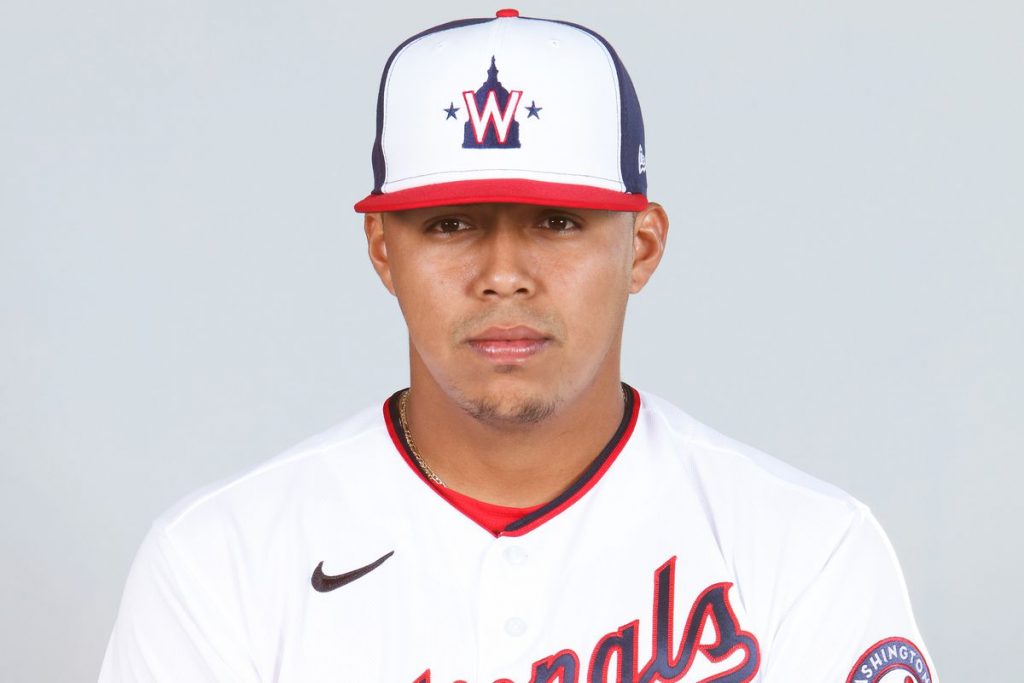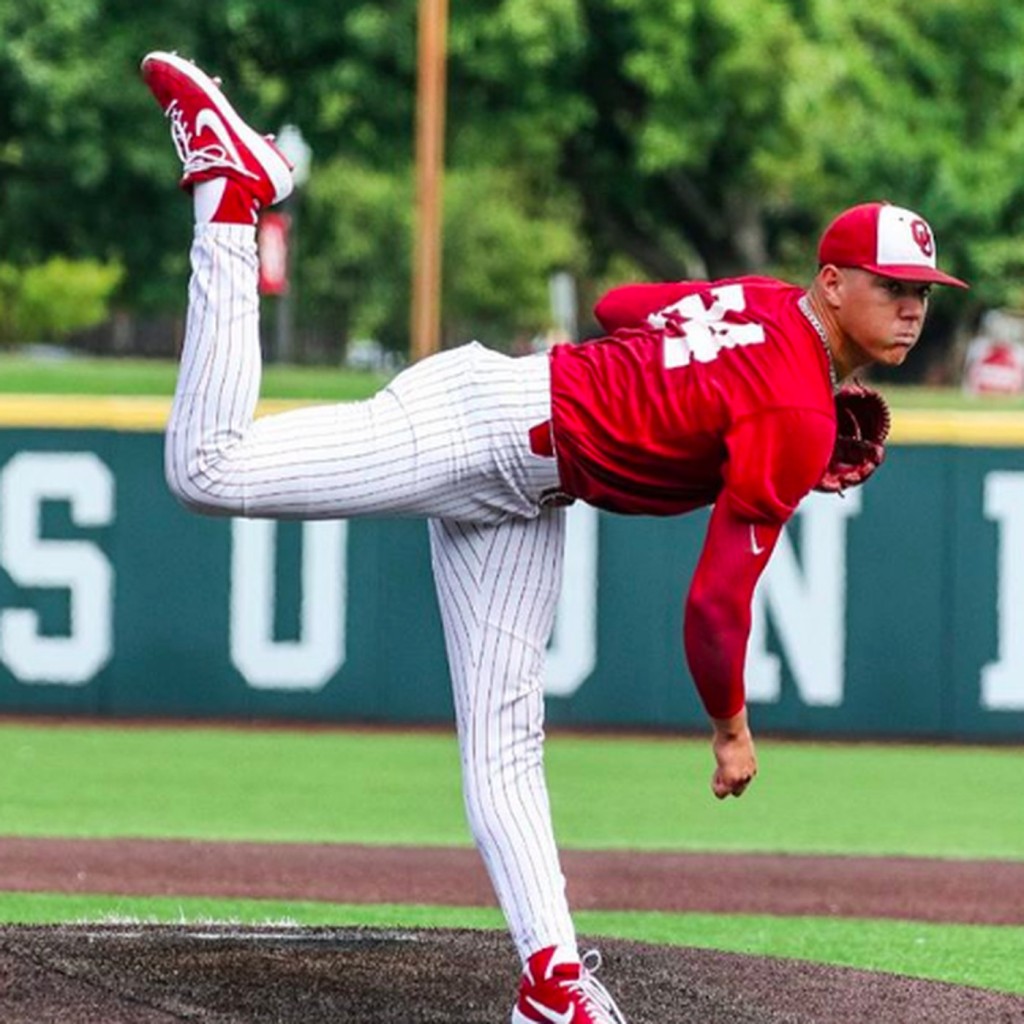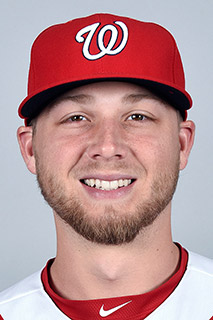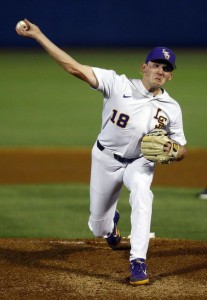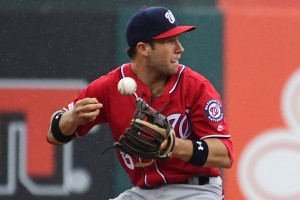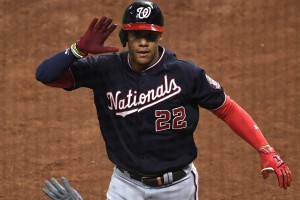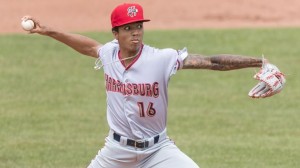
Sharp taken in rule-5 draft, as many of us predicted. Photo unk via talknats.com
The Nats for years were heavy participants in the Rule-5 draft, thanks to some pretty awful teams and no real aspirations to compete on the field. From 2010 on-wards they stopped taking players, but have lost some players here and there. This post is all about players taken and lost in Rule 5 drafts.. We have not posted on this in some time; that’s because its been a while since a player of some significance was taken. Well, on 12/12/19 a player that most of us thought should have been protected a few weeks ago ahead of this draft went 3rd overall to Miami in Sterling Sharp, so I thought it was a good time to bring this back out.
Past versions of this post: December 2016, January of 2014. and November 2011.
Borrowing a chunk of the text for the previous years from the previous post, here’s a list of the Rule 5 drafts since 2005, with our players taken/received noted and with some thoughts on how the player turned out for either side. I’ve tried to update all Rule 5 candidates with career dispositions.
Note: this post used to be to pass judgement on our Rule-5 picks, so when you see “Verdict: Failure” that’s what it means. Its been so long since we tried to draft someone that I forgot what it was like. Suffice it to say … there’s not a lot of success with these picks, either for those we took or those who got taken from us.
(A reminder: These minor league rule-5 acquisitions are essentially $12,000 purchases and the drafters now own these contracts; I’m not entirely clear on the rules that drive them, nor how the players are determined to be eligible, nor if there’s any requirements that the players have to stay on a particular roster).
2021 update: thanks to the lockout, the entire Rule-5 draft was cancelled in 2021.
2020 Update: We selected no one, nor did we have anyone selected from us in either the major or minor league phase of the 2020 Rule-5 draft. So no updates to this post for this year.
MLB beat reporter Jessica Camerato posted a nice Rule-5 history lesson on 12/11/20.
2019 rule 5 Draft (ahead of the 2020 season):
Conducted 12/12/19: Nats did not take any players in the major league phase for the 9th straight year. Sterling Sharp, a 2016 22nd round RHP starter, was taken from us by Miami with the 3rd overall pick. This was a frustration for many pundits, who clearly had identified Sharp as someone to protect ahead of the deadline. With rosters expanding to 26, the Marlins (who are barely trying) get a free prospect who probably can sit in their MLB bullpen all year if he can’t make the rotation. I mean, right now I project the Marlins rotation as the worst in the sport; if Sharp can’t fit into the 5th starter/swing man role for the worst rotation in the majors …
Post Publishing update: Sharp was returned to the Nats on 8/27/20 after four un-impressive appearances for the Marlins.
In the Minor league phase:
- Nats took SS Manuel Geraldo from San Francisco
- Nats had taken from us SS David Masters by the chicago Cubs
Masters is listed as declared a MLFA by milb.com, so i’m not entirely sure how he was still available in Rule-5, but so be it. Perhaps he re-signed under the radar and then got plucked.
So, notable players who we were “worried” about getting picked but who now are safe for another season include the likes of Mario Sanchez, Taylor Gushue, Joan Baez, Andrew Istler, Jakson Reetz, Steven Fuentes, Jhonathan German and Nick Banks.
2018 Rule 5 Draft (ahead of 2019 season)
Full Draft results: The Nats did not take anyone, nor have anyone taken from them in the Major league phase.
In the Minor league phase:
- Nats selected CF Chuck Taylor from Seattle.
- Nats had taken from them C Alejandro Flores by Houston.
Taylor hit a combined .229 across AA and AAA for the Nats in 2019, then hit MLFA. Flores was assigned eventually to High-A in late May 2019. He played 2 games, went on the DL, then was released three weeks later. He picked up with a Mexican League team soon after, barely played there but remains on their active roster.
2017 Rule 5 Draft (ahead of the 2018 season)
Full Draft Results here. The Nats did not take anyone, nor have anyone taken from them in the Major league phase.
In the Minor league phase:
- Nats selected 2B Jacob Wilson from St Louis
- Nats selected RHP Kaleb Fleck from Arizona
- Nats had taken from them LHP Robert “RC” Orlan by Cleveland
Wilson hit solidly for AAA Syracuse in 2018, then started hot in Fresno AAA in 2019 before being released so he could pursue an opportunity in Korean baseball. He remains there today. Fleck was sent to AA Harrisburg for the 2018 season and didn’t pitch badly, but was released in July. He pitched a little bit of Indy ball for a team near his home in PA, but likely retired after 2018 season at the age of 29. Orlan bounced around five different teams for Cleveland in 2018, then settled into AAA to start 2019, got shelled, and was released in May.
2016 Rule 5 Draft (ahead of the 2017 season)
Full draft results here for the 12/8/16. For the sixth straight year, the Nats did not take anyone in the major league phase. For the third time in a row, we did not have anyone taken either. Lets pause to congratulate the team for its excellence in player analysis.
In the minor league phase:
- the Nats did not take anyone
- RHP reliever Philp Walby was taken in the “AAA phase” by Toronto.
We acquired Walby on 5/31/16 as a MLFA from the New York Yankees and he pitched quite ably for us in Hagerstown, with more than a K/inning. He was in his age 24 year though, so clearly “old for the level” and i’m guessing Toronto is banking on him being able to compete in the upper levels immediately. Its notable that milb.com never even bothered to get him in the Hagerstown Suns hat for his profile :-).
Walby pitched of 2017 in-between Low-A and High-A for Toronto’s affiliates, elected MLFA after the season, and has not pitched since.
2015 Rule 5 Draft (ahead of the 2016 season)
This occurred on 12/10/15. The Nationals did not take anyone in the major league phase, nor did they have anyone taken.
In the minor league phase:
- the Nationals selected 3B Zack Cox from the Miami organization
- The Nats did not have anyone taken from them.
Cox was entering his age 27 season, is a former 1st round pick and has bounced around AA and AAA the last four seasons. He seemed like good AAA 3B insurance for the ever-injured Anthony Rendon (hey, has this comment aged well or what?), but Cox never even made it to Syracuse, getting released on 4/2/16 and never picking back up with another franchise.
2014 Rule 5 Draft (ahead of the 2015 season)
For the first time since their arrival in DC, the Washington Nationals neither took a player in Rule-5 nor had one taken.
2013 Rule 5 Draft (ahead of the 2014 season)
The team did not select anyone in the major league phase. We did lose one player in the MLB phase:
- C Adrian Nieto was the 2nd overall pick in the major league phase, by the Chicago White Sox. As commenters at the time noted, it seemed like an odd pick for the White Sox, who had a couple of younger developing catchers in their system. Meanwhile Nieto had never played above A-ball but did hit .285/.373/.449 prior to the 2014 season. Those are pretty good numbers for a catcher … even if he’s an old 24 in A-Ball. I didn’t even mention him in my own pre-Rule5 analysis piece at the time, but amazingly he stuck on the White Sox roster for the entire 2014 season, hitting .236/.296/.340. The White Sox sent him to AA for 2015, he elected FA (presumably after being DFA’d) and signed as a MLFA with Miami for 2016. Nieto continues to bounce around the minors to this day, playing sparingly for AA Jacksonville in 2019.
In the minor league phase, the Nats took a couple of players for organizational depth: Theo Bowe, a AA outfielder from Cincinnati and Martires Arias, a low-A right-hander from the New York Mets. Neither player really panned out: Bowe was left in XST the entire year and Arias was released before the season started.
2012 Rule 5 Draft
Again, the team did not select anyone but got poached for four players in the major and minor phase.
- LHP Danny Rosenbaum was drafted by Colorado to take part in their unique rotation experiment (where guys work up to a certain pitch count each night). Rosenbaum didn’t make the Rockie’s pitching staff out of spring training (somewhat an indictment of Rosenbaum’s skills; Colorado’s rotation was one of the worst in the majors in 2013) and he was returned to Nats. Rosenbaum toiled in AAA for the Nats for the 2013 full season. He was the AAA opening day starter in 2014 but blew his UCL and had TJ Surgery. In Jan 2015 the team flipped him to Boston for Dan Butler, and he got roughed up in Boston’s system (0-8, 5.81 ERA). He was released on 3/28/16 and may be done playing.
- Utility player Jeff Kobernus was drafted by the Boston Red Sox, traded to Tigers and then eventually returned to Nats. Kobernus turned out to be quite the speedster, stealing nearly a base every other game in the minors and earned a call-up to the big team in 2013. He struggled with injury, spending a chunk of 2014 on the 60 day D/L and had just a handful of MLB atbats. The team released him mid spring training 2015, he picked up with the San Francisco organization and played near his home town in San Jose in 2015, struggling in High-A ball. Kobernus never signed after the 2015 season and may be done playing.
- In the minor league phase, Nats draft bust Jack McGeary was taken by the Red Sox. He threw 21 ineffective innings in short-A and low-A for Boston in 2013. He’s from Boston, so it was a nice gesture, but it just doesn’t look like he’s ever going to recover from his arm issues. Hey, at least he got his Stanford education and his bonus money. He signed as a MLFA with the Los Angeles Dodgers organization for 2014, struggled again in A-ball, and did not sign for 2015.
- The Dodgers poached Hector Nelo from the Nats AA team and stuck him on their own AA team … where he promptly made the all-star game again and had another excellent season. I’ll be honest; I do not know the minor league rule-5 protection rules, but I wonder why an all-star player was exposed, no matter what his age. Nelo struggled in 2014, was released and looks like he’s out of affiliated ball. So perhaps the team was a year early but still right in exposing him to Rule 5.
2011 Rule 5 Draft
The Nats did not take anyone for the first time in years, but had two players themselves taken. Neither player drafted was a surprise; I posted at the time that I thought both these players should have been protected.
- Brad Meyers (RH starting pitcher) was drafted by the New York Yankees, but he suffered an injury in spring training and was DL’d all year. He was returned to the Nats and subsequently missed all of 2013 too. I listed him as a “release candidate” in my 2014 rotation projections, not knowing if he was healthy or if he could win a AAA rotation spot that year; he ended up making 6 starts in AA and was released. He’s now out of baseball.
- Erik Komatsu was drafted by St. Louis (in retaliation for our taking Broderick the previous year?), made their 2012 opening day roster, played for a while before being waived, got picked up by Minnesota, and by Memorial Day was returned to Washington in a whirlwind set of transactions. He got hurt in 2013 and played just a few games for the Nats AA and AAA teams, then was released on 5/9/14. He signed immediately with the Angels, bounced to Milwaukee, was a MLFA after the season and did not play in organized ball in 2015.
2010 Rule 5 Draft
- Elvin Ramirez, RH reliever, drafted from the New York Mets: he was injured in spring training and spent the entirety of the season on the DL. Interestingly, the team returned him to New York in October, long before they needed to, and with New York in 2012 he made his way to the majors for some appearances. The Mets eventually sold him to the Angels, then he bounced around in MLFA to Pittsburgh and Cincinnati, and in 2015 was playing in the Mexican league. Verdict: impatience leading to failure.
- Brian Broderick, RH Starting Pitcher, Drafted from St. Louis and stuck into the 2011′s bullpen as the long-man/mop-up guy. He was awful, he was costing the team wins, and was eventually returned to St. Louis before May was out. However, St. Louis waived him towards the end of 2012 and we picked him back up. I projected him to be one of our AAA starters in 2013 but he struggled and ended the season in AA and was cut loose. He pitched in Indy ball in 2014, well enough to get a MLFA contract in 2015, spending the whole year in the Royal’s AAA team. He did not sign or play for 2016 and may be done. Verdict: failure across the board.
The team lost one player in the 2010 draft:
- The Phillies drafted Michael Martinez away from the Nats, and he stuck on their roster as a backup middle infielder. His batting lines were awful though, and the Nats clearly had depth at middle infield at the time, so losing this player was not that big of a deal. Martinez has continued to hit sub .200 but has bounced from Philly to Pittsburgh to Cleveland, splitting time between AAA and the major league rosters providing MIF cover.
2009 Rule 5 Draft
- Jamie Hoffman; OF, Drafted with the #1 pick in the Rule 5 draft from Los Angeles Dodgers and immediately traded for Brian Bruney in a pre-arranged deal. NY returned him to the Dodgers later that spring. Bruney, meanwhile, immediately went to arbitration and lost with the team in the spring of 2010, was awful out of the gate, and the team outright released him before the end of May. Verdict: failure, all the way around this transaction.
The team lost one player in this draft:
- Zech Zinicola was drafted away from us by Toronto, who eventually returned him to the Nats without any Toronto appearances. His selection was probably due to Dana Brown‘s hiring in Toronto, going from Washington’s Scouting Director to being a special assistant to the GM in Toronto. Zinicola remained in our farm system until 2013, when he was released.
2008 Rule 5 Draft
- Terrell Young: Drafted with the #1 pick in the Rule 5 draft from Cincinnati. He got hurt, never played for us, and was eventually returned to the Reds. His injury was severe enough that he was out of baseball after being drafted; he has no professional games after 2008. Verdict: failure.
- Ricardo Nanita, selected in the minor league phase, played most of 2009, then went to the Mexican league, then got picked up by Toronto in minor league free agency and has been there ever since, playing all of 2013 in Buffalo. Verdict: failure.
The team lost two players in the minor league phase:
2007 Rule 5 Draft
- Matt Whitney: 1B/3B, Drafted and then eventually returned back to Cleveland, who eventually made the former 1st rounder a ML free agent and we signed him after the 2008 season. We cut him after the 2009 season and he retired after 2010. Verdict: failure.
- Garrett Guzman: LF/RF: after Rule-5 selecting him, the team eventually traded a PTBNL for him to Minnesota, then we cut him outright and nobody picked him up. He played two years of Independent ball and was out of baseball after 2010. Guzman is more infamously known as the player who was caught having sex with an underage girl while playing for our AA team in Harrisburg in 2008, likely the reason why nobody picked him up after his DFA. Verdict: embarrassing failure.
The Nats lost one player of note in the minor league phase in this draft:
- Brett Campbell was drafted by Milwaukee in the AAA phase of the rule-5 draft. Milwaukee released him in spring training of the subsequent 2008 season and Campbell never played another inning of pro baseball. This seems especially odd to me: he was drafted in 2004 and rose all the way through the Nats system to debut in the majors by Sept of 2006. He pitched in just two games in 2006, and returned to the minors in 2007. Was he hurt? He was only 26 when he apparently hung them up. Oddity.
2006 Rule 5 Draft
- Jesus Flores, C, drafted from the New York Mets, stuck with the team all year despite having only played high-A ball in the minors. Despite his eventual injury issues that plagued him for the better part of 3 seasons, Flores remains the best example of a “found gold” prospect that can be had in the Rule 5 draft. After the Nats DFA’d him last off-season, he bounced around both LA and Tampa’s AAA teams in 2013 but did not appear in the majors. Verdict: success.
- Levale Speigner RHP (a closer) was drafted from Minnesota and, as with Booker above, eventually was traded for by the Nats so they could keep him and stash him in the minors. After some awful outings for the big team, he passed through waivers mid 2008 and was released from AAA in 2008, bounced around a couple other organizations, and retired after 2010. Verdict: failure.
The Nats lost one player in this draft:
- Alejandro Machada was drafted by Minnesota just a month after the Nats had re-signed him to a minor league contract. So Machada didn’t have to stay on their active roster. And indeed he didn’t; he was injured all of 2007 and stayed with Minnesota’s AAA team until 2009, never again broaching the majors.
2005 Rule 5 Draft
The Nats did not draft anyone, but had a player taken who went on a whirlwind tour of MLB organizations before getting returned mid 2006.
- Chris Booker was rule-5 drafted by Detroit, who immediately sold him to Philadelphia, who then waived him in May of 2006 with the intent of returning him … except that Kansas City picked him up, hung onto him for a couple months and eventually returned him to Washington. The Nats eventually called him up but he was relatively ineffective and he washed out of the game (seemingly due to injuries) after 2008.
2004 Rule 5 Draft (ahead of the 2005 season)
- Tony Blanco: 1B; drafted from Cincinnati. He batted .177 as a 1st baseman backup while eating a roster spot all season, then we cut him from AAA after 2007. He kicked around Colorado’s system for a year and has been playing in Japan ever since. Verdict: failure.
- Tyrell Godwin: CF, drafted from Toronto. Prior to the 2005 season, the team traded another minor leaguer to keep his rights, so this really played out less like a Rule-5 pickup in that Godwin didn’t have to stick on the 25-man roster all year. He played a grand total of 3 games for the Nats, kicked around AAA for a while an hung them up in 2007. Verdict: failure.
Summary: we’ve drafted 11 guys in the MLB phase Rule 5 draft since 2005, and I’d classify 10 of the 11 draftees as eventual failures. Not a great track record. Plus its safe to say that most every player drafted FROM us has been a failure for the drafting team. Clearly the Rule 5 draft isn’t a great way to reliably find players. Why do we do so much analysis on it? I dunno, because its fun? Because its December and we’re desperate for Baseball news? Fair enough 🙂
